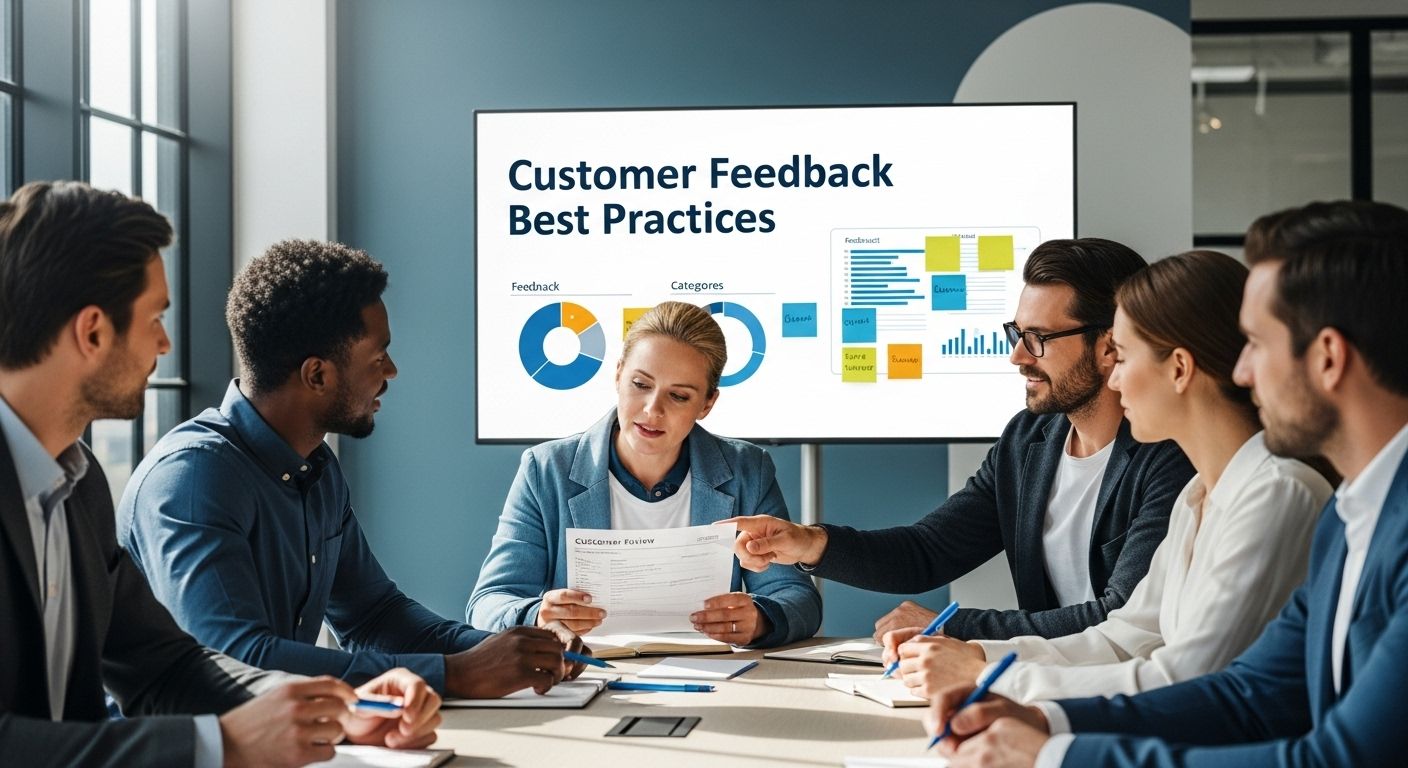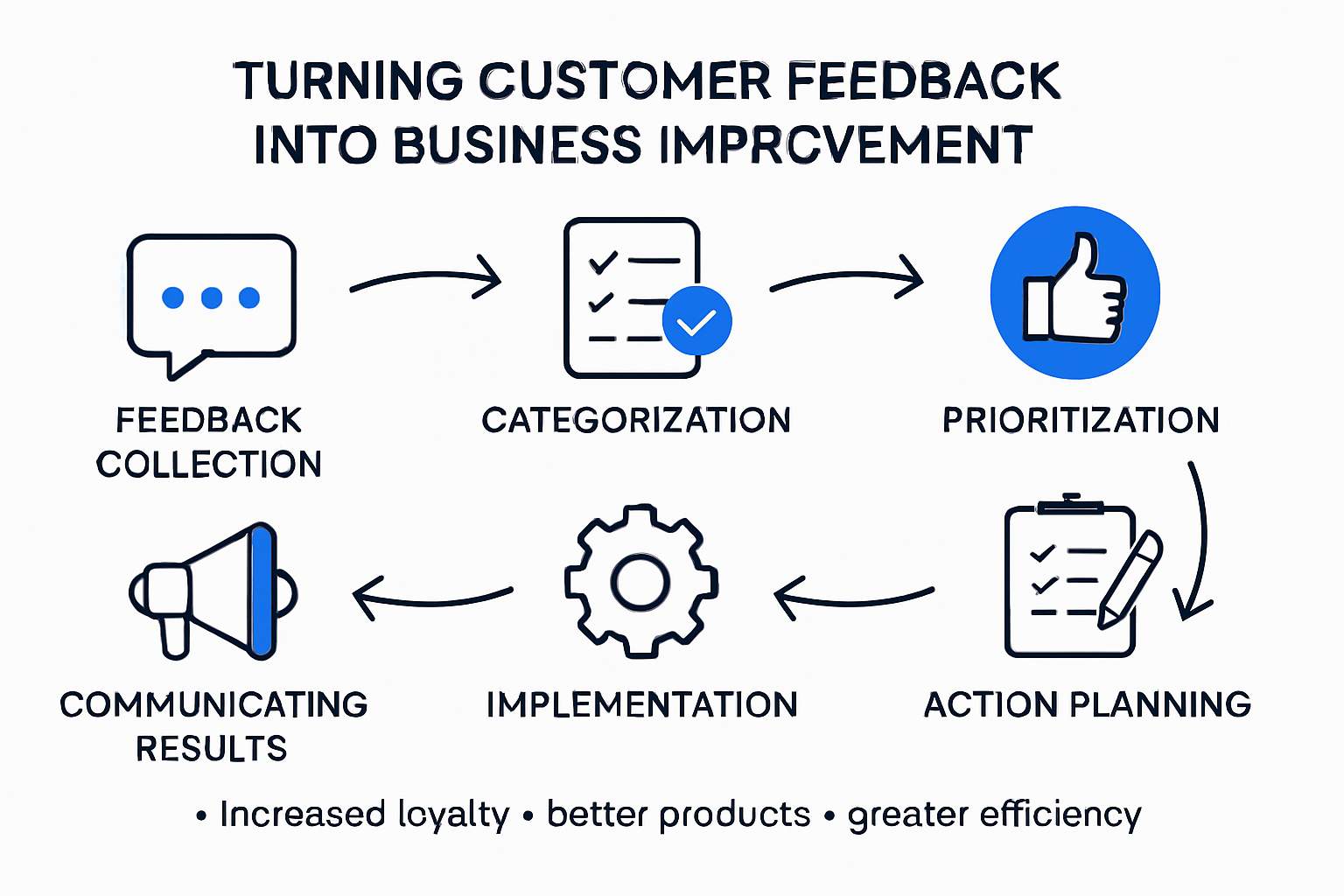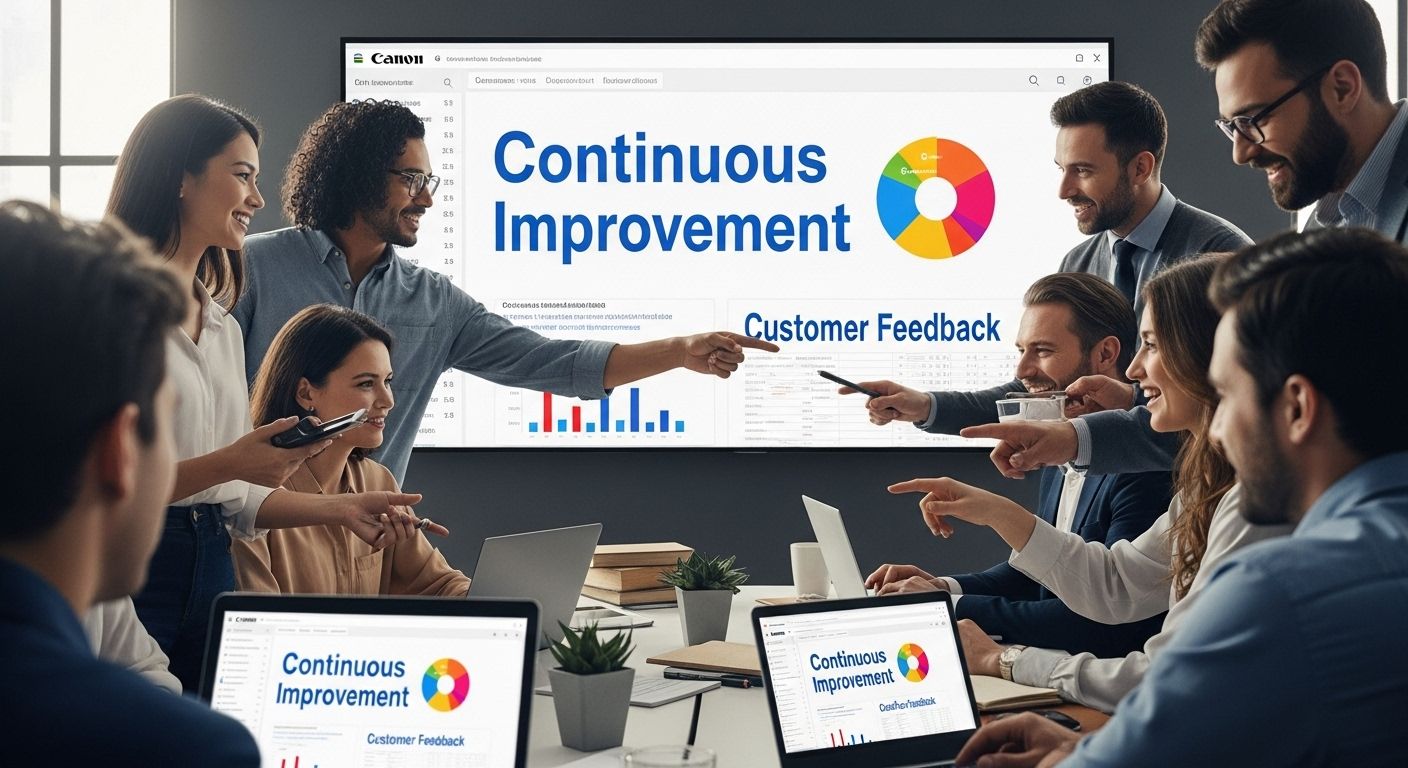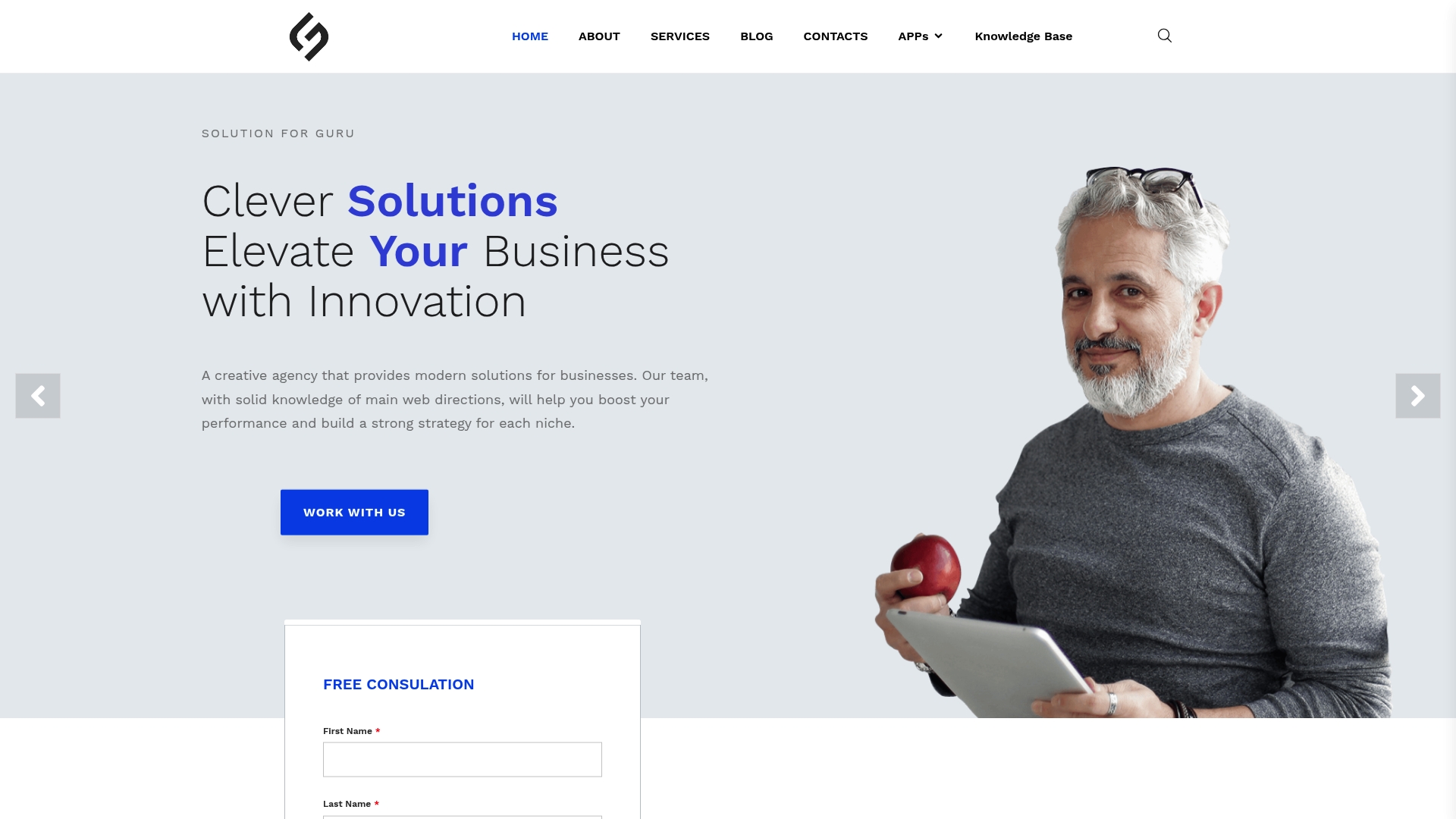Customer Feedback Best Practices for Business Growth

Every business talks about listening to customers, yet most overlook how feedback can really move the needle. Nearly 70 percent of companies that collect and act on customer feedback outperform their peers in growth. You might assume gathering opinions is enough, but real success only happens when teams turn feedback into clear action and let customers see the results.
Table of Contents
- Collecting Customer Feedback Effectively
- Using Feedback To Improve Products And Services
- Incorporating Feedback Into Business Strategy
- Empowering Teams With Customer Insights
Quick Summary
| Takeaway | Explanation |
|---|---|
| Develop multiple feedback channels. | Utilize surveys, social media, and feedback widgets to gather customer insights effectively. |
| Create actionable feedback questions. | Frame questions that are specific, unbiased, and can lead to tangible improvements. |
| Implement a continuous feedback loop. | Regularly analyze and act on feedback to ensure ongoing improvements and customer satisfaction. |
| Integrate feedback into strategy. | Use customer insights to shape marketing and operational strategies for better business alignment. |
| Foster a customer-centric culture. | Encourage all teams to prioritize customer insights and collaboration to enhance overall experience. |
Collecting Customer Feedback Effectively
Customer feedback represents the critical lifeline connecting businesses with their audience’s genuine experiences and expectations. Effective collection of this invaluable information requires strategic approaches that go beyond traditional survey methods.
Creating Comprehensive Feedback Channels
Businesses must develop multiple touchpoints for gathering authentic customer insights. According to research published on arXiv, organizations should actively engage in structured activities that leverage diverse feedback sources, including digital platforms, direct communication channels, and interactive feedback mechanisms.
The most successful feedback strategies integrate both quantitative and qualitative data collection methods. This means combining numerical ratings with open-ended responses that provide deeper context about customer experiences. For instance, after a purchase or service interaction, companies can implement:
Here is a summary table outlining the main types of customer feedback channels and key characteristics for each, as discussed in the article. This can help businesses quickly compare and choose the most effective feedback methods for their needs.
| Feedback Channel | Main Features | Example Use Case |
|---|---|---|
| Survey Tools | Short, targeted, quantitative & qualitative questions | Post-purchase feedback forms |
| Website Feedback Widgets | Real-time, user-friendly, direct-to-site interaction | On-site pop-up asking for user input |
| Social Media Monitoring | Monitors comments, mentions, and messages | Tracking product mentions on Twitter |
| Direct Communication | One-on-one, personalized responses | Customer support call or email |
| Interactive Mechanisms | Engaging digital touchpoints for active input | In-app satisfaction ratings |
- Survey Tools: Short, targeted questionnaires with clear, concise questions
- Website Feedback Widgets: Real-time response options embedded within digital platforms
- Social Media Monitoring: Tracking comments, mentions, and direct messages
Designing User-Centric Feedback Mechanisms
Digital.gov recommends crafting feedback requests that prioritize user experience and data quality. This involves developing questions that are:
- Specific: Narrow in scope to obtain precise insights
- Actionable: Designed to generate implementable recommendations
- Unbiased: Neutral in language to prevent leading responses
The key is creating an environment where customers feel comfortable and motivated to share honest perspectives. This means minimizing friction in the feedback process and demonstrating that their input genuinely matters to your organization.
Transforming Feedback into Strategic Improvements
Collecting feedback is only the initial step. The true value emerges through systematic analysis and strategic implementation of insights. Businesses should establish a structured workflow that includes:
The process below summarizes the essential steps for transforming collected customer feedback into strategic business improvements. This process table organizes the article’s recommendations into a clear, repeatable workflow.
| Step | Description |
|---|---|
| Categorize Feedback | Group input by themes and impact for better organization |
| Prioritize Actionable Recommendations | Select feedback with the biggest potential value |
| Develop Implementation Plans | Create clear roadmaps to address prioritized feedback |
| Communicate Changes to Customers | Notify customers about improvements based on their feedback |
| Monitor and Repeat | Review outcomes and continue the feedback cycle |
- Categorizing feedback by themes and impact
- Prioritizing actionable recommendations
- Developing clear implementation plans
- Communicating changes back to customers
By treating customer feedback as a continuous dialogue rather than a one-time transaction, organizations can create adaptive strategies that evolve with customer needs. This approach transforms feedback from a passive data collection exercise into a dynamic tool for innovation and customer satisfaction.

Remember that the most effective feedback systems are those that make customers feel heard, valued, and integral to the business’s growth journey. Transparency, responsiveness, and genuine commitment to improvement are the cornerstones of building trust through customer feedback practices.
Using Feedback to Improve Products and Services
Transforming customer feedback into meaningful product and service improvements requires a strategic and systematic approach. By carefully analyzing and acting on customer insights, businesses can create more responsive and customer-centric solutions.
Mapping the Customer Journey
Research from Marquette University highlights the critical importance of customer journey mapping as a powerful technique for understanding and enhancing customer experiences. This process involves meticulously tracking every interaction a customer has with a brand, identifying potential friction points, and developing targeted improvements.
Customer journey mapping allows businesses to:
- Visualize Complete Customer Experience: Track interactions across all touchpoints
- Identify Pain Points: Recognize areas of customer frustration
- Prioritize Improvements: Focus resources on most impactful enhancements
By creating a comprehensive view of the customer experience, organizations can develop more intuitive and user-friendly products and services that directly address customer needs and expectations.
Implementing Feedback-Driven Improvements
Effective implementation of customer feedback requires a structured approach. This means moving beyond simply collecting insights to creating actionable strategies for product and service enhancement. Critical steps include:
- Categorizing feedback by frequency and potential impact
- Developing clear implementation roadmaps
- Creating cross-functional teams to address specific improvement areas
- Establishing metrics to track the effectiveness of changes
The Minnesota Department of Health recommends developing a robust communication plan that specifies how feedback insights are shared across the organization. This ensures that valuable customer perspectives reach the right teams and can be transformed into meaningful improvements.
Continuous Improvement and Feedback Loop
Creating a sustainable feedback-driven improvement process requires establishing a continuous loop of collection, analysis, implementation, and validation. This means:
- Regularly revisiting customer feedback
- Tracking the impact of implemented changes
- Maintaining open communication channels with customers
- Demonstrating tangible results of customer input
Successful organizations view customer feedback as a dynamic, ongoing conversation rather than a static data collection exercise. By treating customer insights as a valuable resource for innovation, businesses can create products and services that continuously evolve to meet changing customer needs.
Ultimately, the most successful approach to using feedback involves genuine commitment, transparency, and a willingness to adapt. Customers want to know that their voices are not just heard but actively shape the products and services they use. This approach transforms feedback from a passive data point into a powerful driver of business innovation and customer satisfaction.
Incorporating Feedback into Business Strategy
Customer feedback represents more than just isolated comments. It is a strategic asset that can fundamentally reshape business direction, operational approaches, and competitive positioning when integrated thoughtfully into organizational planning.
Transforming Feedback into Strategic Insights
Research by Walden University reveals that successful businesses view consumer feedback as a critical component of marketing strategy. By systematically analyzing and responding to customer perspectives, organizations can build stronger relationships, enhance brand awareness, and drive profitability.
Strategic integration of feedback involves several key processes:
- Comprehensive Data Collection: Gathering insights from multiple channels
- Systematic Analysis: Identifying patterns and meaningful trends
- Cross-Departmental Collaboration: Ensuring insights reach relevant teams
- Actionable Implementation: Developing targeted strategic responses
Advanced Feedback Analysis Techniques
Digital.gov highlights emerging techniques like natural language processing that enable organizations to transform qualitative feedback into structured, actionable intelligence. These advanced methods include:
- Aspect-level sentiment analysis
- Topic modeling
- Predictive trend identification
- Automated insight generation
By leveraging sophisticated analytical approaches, businesses can move beyond surface-level understanding to develop nuanced strategies that anticipate and address customer needs proactively.
Building a Feedback-Driven Organizational Culture
According to Marquette University’s business research, creating a feedback-responsive culture requires more than technical tools. It demands a fundamental shift in organizational mindset that views customer perspectives as a strategic priority.
Key elements of a feedback-driven culture include:
- Leadership commitment to customer-centricity
- Transparent communication about feedback implementation
- Reward systems that recognize customer-focused innovation
- Continuous learning and adaptation mechanisms
Businesses that successfully incorporate feedback into their strategic planning create a dynamic environment of continuous improvement. This approach transforms customer input from a passive data point into an active driver of organizational evolution, enabling companies to stay agile, responsive, and competitive in rapidly changing markets.
The most effective strategies recognize that customer feedback is not a destination but an ongoing journey of understanding, adaptation, and mutual growth. By embracing this perspective, organizations can turn customer insights into a powerful catalyst for strategic innovation and long-term success.
Empowering Teams with Customer Insights
Customer insights represent a powerful resource that can transform organizational performance when effectively shared and utilized across different team functions. Empowering teams with meaningful customer feedback requires strategic approaches that break down traditional departmental silos and create a unified understanding of customer experiences.
Democratizing Customer Understanding
According to the U.S. General Services Administration, fostering a customer-centric culture demands embracing partnerships and keeping the end user at the center of service design. This approach means moving beyond traditional hierarchical information sharing to create a more transparent and collaborative environment.
Effective democratization of customer insights involves:
- Cross-Departmental Knowledge Sharing: Ensuring feedback reaches all relevant teams
- Accessible Reporting: Creating clear, understandable insight summaries
- Interactive Feedback Platforms: Developing tools that enable real-time information exchange
- Training Programs: Educating teams on interpreting and applying customer data
By making customer insights universally accessible, organizations can help every team member understand how their work directly impacts customer experiences.
Creating Collaborative Feedback Mechanisms
Transforming customer insights into actionable strategies requires creating robust collaborative frameworks. This means developing systems that:
- Enable quick communication across departments
- Provide context for customer feedback
- Allow for rapid response and iteration
- Recognize and reward customer-focused problem solving
Successful collaboration happens when teams view customer insights as a shared responsibility rather than a siloed function. This approach breaks down traditional barriers between marketing, product development, customer service, and other critical business units.
Building a Customer-Centric Organizational Culture
Empowering teams with customer insights goes beyond technical tools and platforms. It requires a fundamental cultural shift that places customer experience at the heart of organizational strategy. This means:
- Leadership modeling customer-focused behaviors
- Creating incentive structures that reward customer-centric thinking
- Developing continuous learning opportunities
- Encouraging open dialogue about customer experiences
Teams that feel genuinely connected to customer perspectives become more innovative, responsive, and motivated. They move from passive information recipients to active problem solvers who understand the direct impact of their work on customer satisfaction.

The most successful organizations recognize that customer insights are not just data points but living, breathing narratives that guide strategic decision making. By creating an environment where every team member feels responsible for understanding and improving customer experiences, businesses can unlock unprecedented levels of innovation and performance.
Ultimately, empowering teams with customer insights is about creating a shared mission. It transforms customer feedback from a passive report into an active catalyst for organizational growth, ensuring that every team member feels connected to the broader goal of delivering exceptional customer value.
Frequently Asked Questions
How can I effectively collect customer feedback?
To effectively collect customer feedback, develop multiple feedback channels such as surveys, social media monitoring, feedback widgets on websites, and direct communication options. Combining quantitative and qualitative data will provide richer insights into customer experiences.
What strategies can I use to turn feedback into actionable improvements?
To turn feedback into actionable improvements, categorize the feedback by themes, prioritize actionable recommendations, develop clear implementation plans, communicate changes back to customers, and establish a continuous monitoring process to evaluate impact.
How can customer feedback influence my business strategy?
Customer feedback can influence business strategy by providing valuable insights that shape marketing and operational approaches. By systematically analyzing customer perspectives, organizations can enhance product offerings, improve customer relations, and drive profitability.
What are the benefits of fostering a customer-centric culture?
Fostering a customer-centric culture encourages all teams to prioritize customer insights, leading to improved collaboration, innovation, and responsiveness. This culture enhances overall customer satisfaction and positions the organization to better adapt to changing customer needs.
Ready to Turn Customer Feedback Into Real Business Growth?
Are you finding it difficult to transform customer comments into practical improvements and measurable results? Many businesses collect feedback but struggle to use it for meaningful change, leaving them a step behind competitors who actively close the feedback loop. The article showed how vital it is to create a continuous feedback process, map the customer journey, and keep teams engaged with data-driven insights. These best practices are important, but implementing effective systems can be challenging without the right digital expertise.

Let Solution4Guru.com guide your next move. Our team specializes in building modern web solutions, AI-driven analysis tools, and digital strategies that turn your customer insights into real improvements. Whether you need custom feedback mechanisms, an intuitive website, or seamless automation for your operations, our experts offer free consultations and tailored strategies to help you take action. Visit Solution4Guru.com to see how we combine technology with a customer-centric approach, and explore our Our Services section to find the perfect solution for your needs. Act today to see faster results and set your business apart.



